
The Temple of Jupiter, right, is thought to be the oldest temple in the Roman Forum.
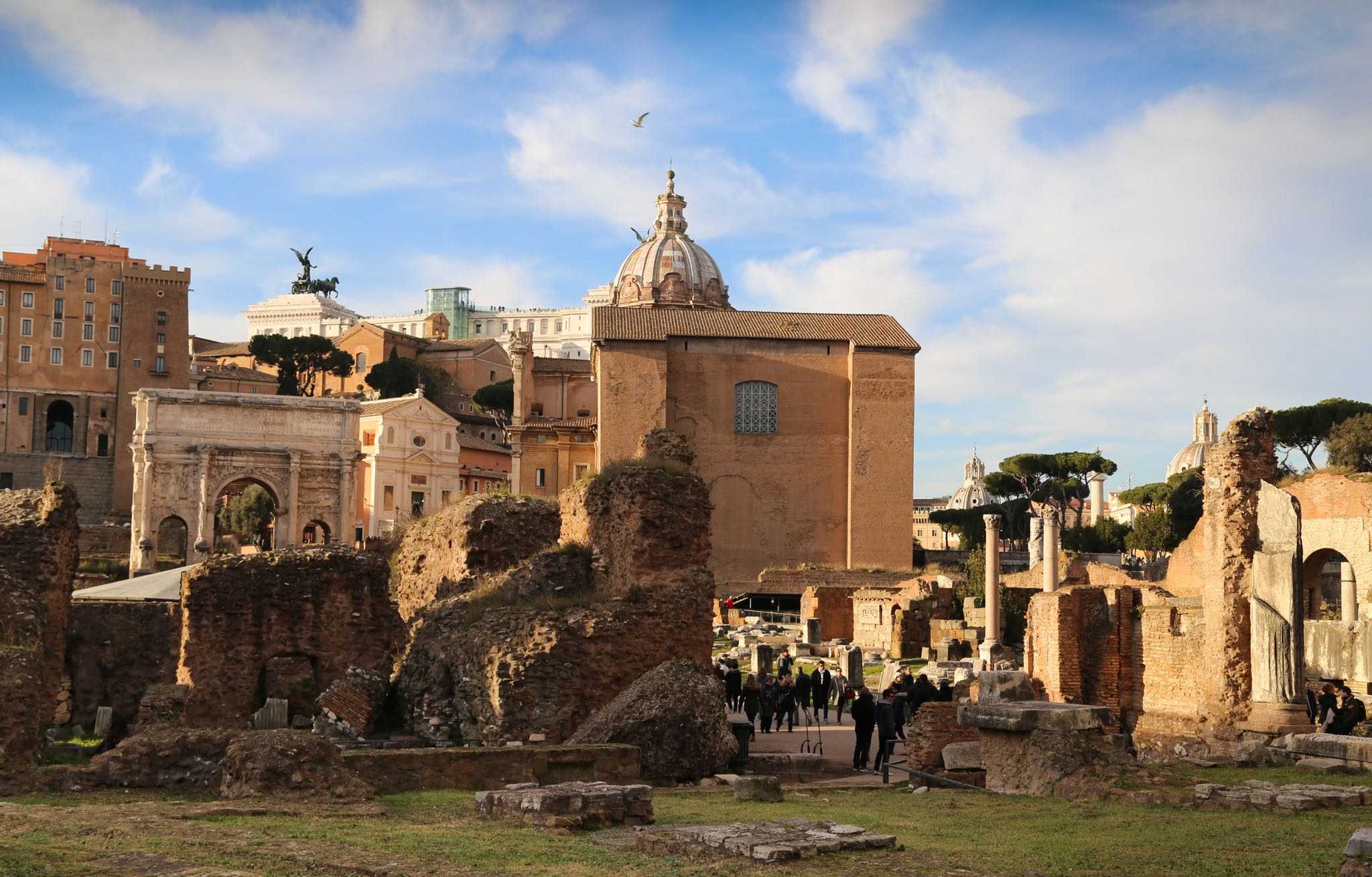
For centuries, people from around the world have flocked to Rome to take in the sights, history, and beauty of one of the most popular tourist destinations in the world.
The founding of Rome is a story steeped in myth, made bigger by hyperbole, and became a place that has literally been cemented into history as one of the greatest cities of Western Civilization. And if legend is to be taken as fact, Rome is named after a murderer.

Commonly referred to as the “wedding cake” the gleaming white iconic building was constructed in the 19th Century to honor Victor Emmanuell II, the first king of a unified Italy.

St. Peter’s Basilica can be seen from many spots in Rome, as in this view from the Aventine Hill.
Rome is generally accepted to have been established in 753 BC. However, archeological evidence exists of people living in the area as far back as 14,000 years. The land, climate, access to water from the Tiber River, and natural defenses of the area’s hills made it a strategic choice. A pair of brothers, Romulus and Remus, are a well-known and they are critical element of the city’s founding. Depending on who tells the tale, variations abound, and different versions were created to satisfy one narrative or another. (One telling suggested the brothers were of Greek origin, something that would not sit well with Greek-jealous Romans.) Or perhaps Romulus and Remus were sons of a Trojan War hero, early ancestors of Julius Caesar, the spawn of the god Mars, or the sons of the demi-god Hercules? But all those stories circle back to a key point – Romulus and Remus were raised and suckled by a she-wolf. A bit preposterous, certainly, but that’s the sort of grist that produces a good legend.

In many cases the antiquities of Rome are strewn about, testament to the fact that there is so much history in Rome that archeologists and scholars sometimes leave some pieces and fragments on the ground.
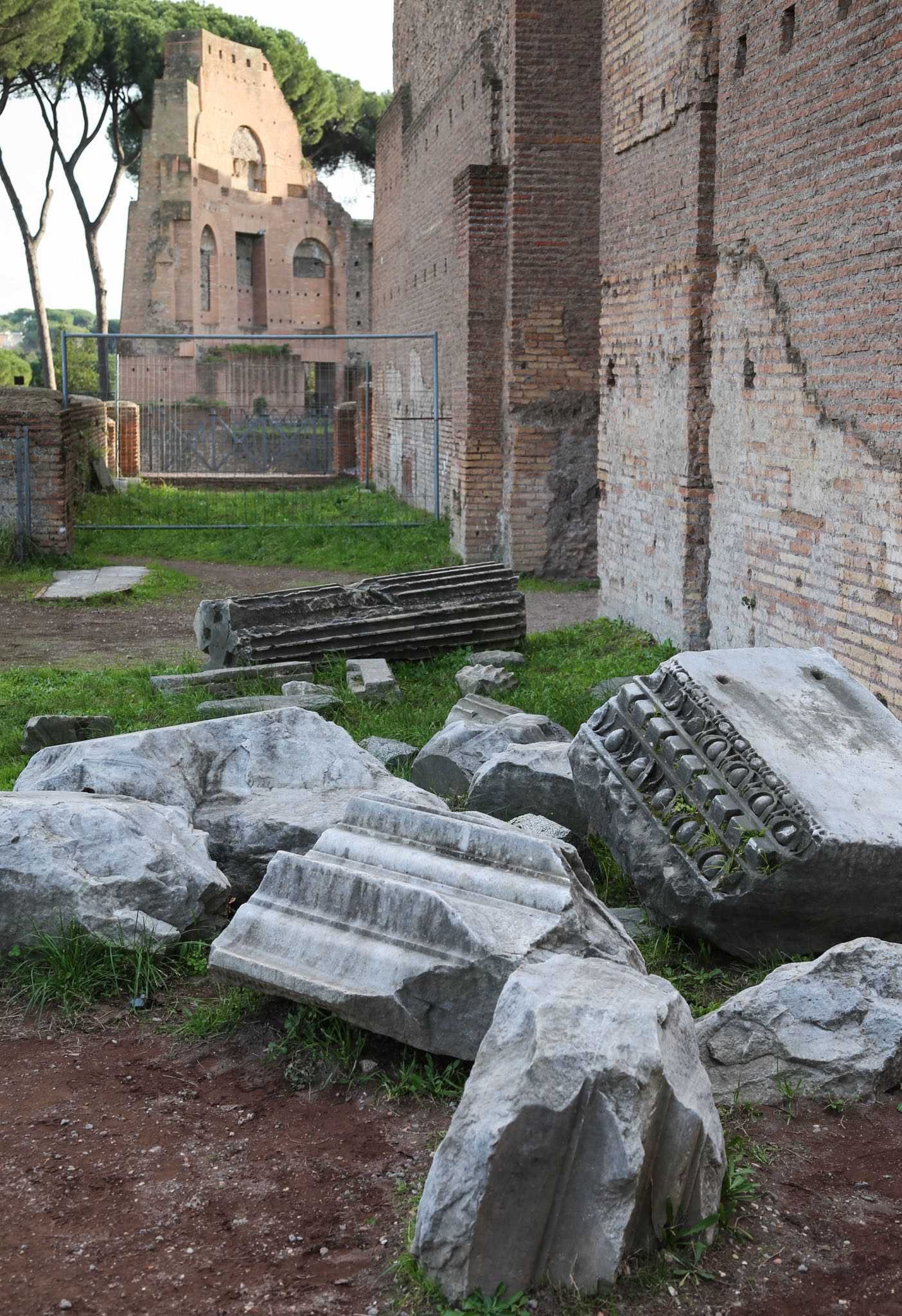
Despite the hodgepodge appearance, it is likely that each of the pieces of stone have been identified and catalogued in an archive to aid in future research and restoration.
As the story unfolds, the brothers, rescued from the she-wolf, were raised by a farmer and his wife, until Romulus and Remus became adults. They decided to found a city, and the area with seven hills was chosen (the central part of present-day Rome). But an argument broke out between them; Romulus killed Remus, then named the city after himself.

The greatness of the Roman Empire was a continuing process of building, expansion, and adaptation of styles from other cultures, such as Greek and Etruscan influences. Centuries of exposure to the elements combined with the use of softer materials like limestone and sandstone is causing significant wear on many of the buildings and statues of ancient Rome as seen in this photograph of the Arch of Settimio Severo in the Roman Forum.

Circus Maximus the first and largest stadium of the Roman Empire, is located in the valley between the Aventine and Palatine hills. It served as a chariot-racing venue, a place for religious celebrations, gladiatorial contests, and athletic events. It was more than 2,000 feet long and 387 feet in width and the seating area could accommodate around 150,000 spectators. This view is from the south east end.
The early centuries, several decades after Rome’s founding, until about 510 BC, was an era of non-hereditary kings. Due to an unforgivable transgression by the son of a king, the monarchical system was rejected and replaced by a republic with a leader chosen by the members of the Senate. There are three eras of the ancient Roman Empire. The first, Period of Kings dates from 625 to 510 BC. The second era is when Rome was a republic, from 510 to 31 BC, and the final chapter of the empire was Imperial Rome from 31 BC to 476 AD. At its height, around 117 AD, the Roman Empire covered an area larger than the United States of America (bear in mind the Mediterranean Sea was in the middle of the empire).

As Rome became more developed and grew in stature, it became a center of commerce, ambition, and empire building. For centuries people have been traversing this street as they go about their daily activities and live out their lives.

Even in Rome, day to day life goes on. For many residents that means visiting the market to purchase food and other goods. A woman, left, cleans and prepares greens as shoppers go about their business.

One of the delights of Rome is the food. The entire Italian peninsula has a smorgasbord of tastes. Shoppers are buying meats, cheeses, and eggs from this small shop.

With so many shops to choose from, window dressing that pleases the eye and informs as to the wares to be found inside is an important part of doing business. This looks like an ideal spot to find some excellent cookies and sweets.

This is one of a number of ‘one-stop’ shops where Roman Catholic clergy can purchase new vestments and iconography for their churches and cathedrals around the world.

Rome is truly an international city and attracts people from everywhere. Here a woman plays a bandura, a Ukranian stringed instrument that combines elements of the lute and zither. Prior to the 1940s it was also referred to as a kobza.
The year 451 B.C. is pivotal because it marks one of the significant achievements of Rome, and is among the cluster of accomplishments that distinguishes the Roman Empire as one of the great influencers of our world. That was when the Twelve Tables were produced. It codified a set of laws on subjects such as equality under the law, property rights, penalties and sanctions for violations (arson was an agricultural crime punishable by death), procedures for redress, and a requirement to appear before a judicial body (a forerunner of habeas corpus). The laws were reproduced onto 12 bronze tablets and displayed in the Senate for all to see. Roman law is often cited as the early model for the legal system developed in the Western World, including the United States. But over time other ideas from Rome continue to have lasting impact.

One of ancient Rome’s great accomplishments was the establishment of the Twelve Tablets, a set of laws, proscriptions, and manners of redress that became a foundational concept of Western laws. The Tablets were displayed in the Senate for all to see. The Via Sacra is the main street that runs through the Forum where the Senate is located.

The sculpture near the Colosseum known as “Lapidarium” or Skeletal Horse by Mexican artist Gustavo Aceves, is a traveling exhibit that spent six months in Rome. Part of the sculpture’s intent is to shine a spotlight on the world’s diaspora.

The views throughout Rome reflect a timeless beauty and testament to the presence of the Roman Catholic Church.

Catholic churches are built to convey a message — as a focus for people’s attention and devotion, as a gathering place for worship, and a location to proclaim their adoration of God. The insides of many churches are richly adorned to tell the stories of faith and the saints and angels that are part of the faith.

Yes, it makes a beautiful backdrop for newlyweds, and today the Castel Sant’Angelo is owned by the Roman Catholic Church and has been used in the past as a fortress to protect the pope in times of strife and war. It was originally constructed for the emperor Hadrian to be used as a mausoleum for him and his family.

According to legend, St. Michael the Archangel appeared atop the building and sheathed his sword, signifying the end of the 590 plague, so the former mausoleum was renamed Castel Sant’Angelo. It once served as a fortress, and later a prison. It is now part of the Vatican museum,
Rome’s military conquests and achievements helped it become one of the largest empires of the ancient world thanks to military advances and developments, but also improvements in communications, and a network of roads. Other major accomplishments that have contributed to the advance of civilization include the aqueduct, an engineering marvel that transports water over vast distances using gravity and building skill. The arch, a building technique now common throughout the world enables structures to have height, volume, light, and beauty. (The Colosseum and Pantheon are two examples of the enduring appeal of Roman construction.) To this day Roman cement is considered some of the finest and longest-lasting concrete ever developed. (The Pantheon is a prime example of engineering, construction, materials management, and classic elegance. The structure is built entirely of concrete that was poured continuously; slip form construction was invented by the Romans.) Roman literature is a foundation of Western literature, and the art of rhetoric was first developed by the ancient Romans who wrote down their speeches and arguments. And finally, the Julian calendar allows the world a simple yet precise system to keep track of the days, weeks, months, years, and leap years of our planet’s journey around the sun.

Rome was among the preeminent builders of the ancient world and one of their great and lasting accomplishments was the arch. Though simple in concept, it was a revolutionary development that allowed builders to create more space and give a pleasing look to the structure.

Those who established Rome and helped mold the empire into greatness perfected a number of talents. Building and harmonizing elements to blend beauty and function together was often the result, as shown by this enlarged photograph of the piece at the end of the portico.
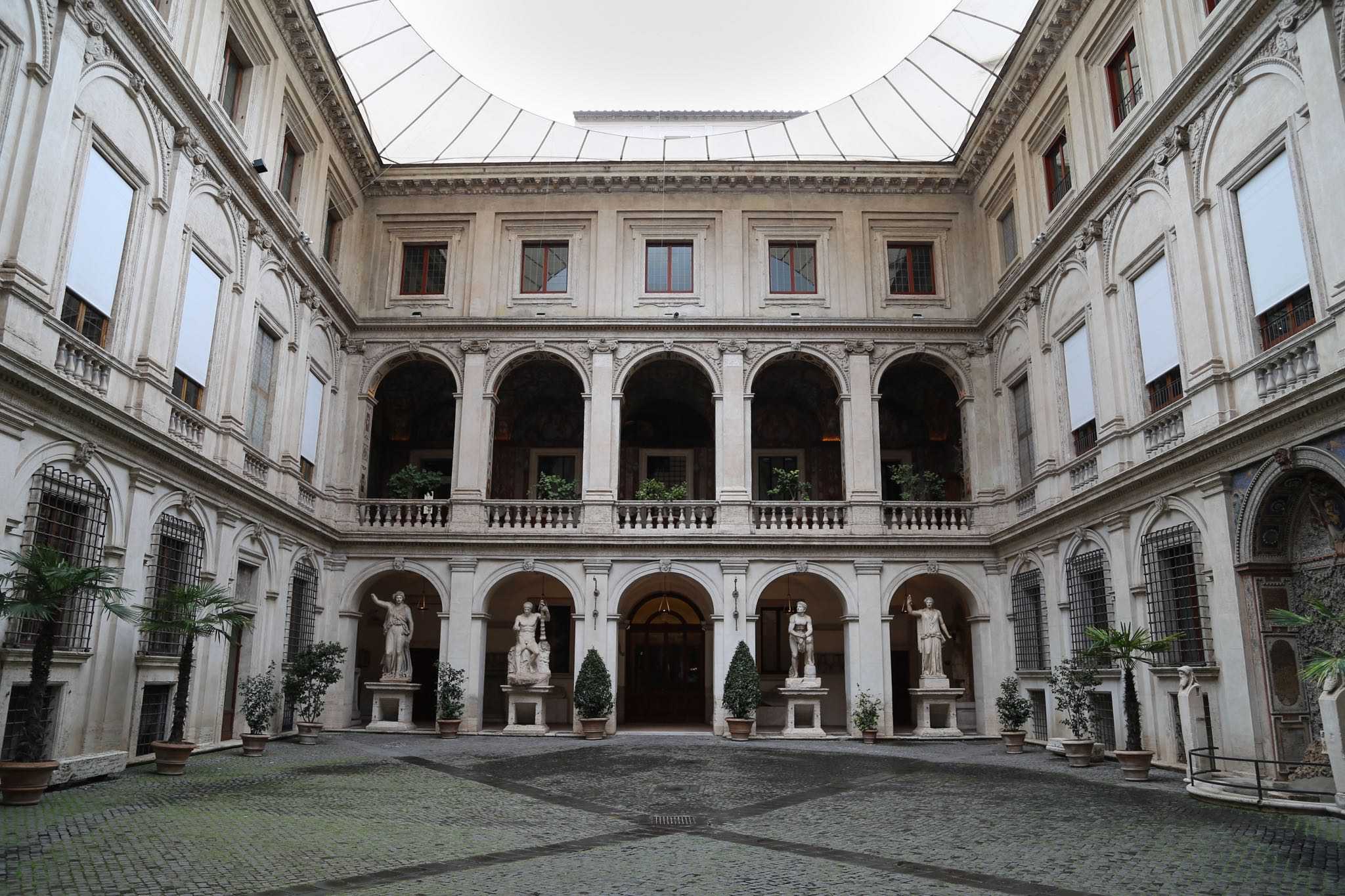
This is another excellent example of the grace, beauty, and functionality that arches contributes to a building.
It is understandable to be awed by the great successes of the Roman Empire, but there are also a number of dark elements to consider. Like many cultures of that time, Romans enslaved conquered people to carry out the drudge work that allowed an elite class to live in luxury. Being conquered by Rome meant a large number of people would become slaves to work the mines, fields, and low-level jobs. An attitude of conquest, in order to feed an ever-needy class of elites led to continuous wars throughout the Roman Empire. Never-ending war created shifting alliances within the empire’s leadership, resulting in instability, coups, murders, and revolts. To Rome, and the world’s detriment, women were excluded from participating in politics, fostering misogyny.

The remnants of Rome can be seen throughout the city, and in this case modern buildings surround a site that is graced by flat-topped trees commonly referred to as umbrella pines or stone pines. In the bottom left a cat rests, soaking up some warm sun while tourists take photos.

The preservation of ancient artifacts is an ongoing activity in Rome. A restoration expert carefully cleans a piece that features a peacock while a visitor looks on. The activity took place in a corridor at the Porta San Paolo.
Through the centuries the Roman Empire soared, then crashed. But where did it go wrong? From being a nexus of enlightenment and ideals, Rome squandered her greatness and succumbed to the failings all too common of great empires. Ambition was an essential ingredient in her demise. Conquering vast reaches of territory required holding, governing, and profiting from it. Conquered peoples do not generally stay conquered forever, something Rome failed to grasp. A class of elites who made all the money and did none of the work created a dependency on peons and slaves. Fostering a climate where the masses were kept in check thanks to state largesse, lulled the elites into complacency. The upper crust thought they controlled the hoi polloi who were driven by fickle whims. And competition to become emperor created a rotten system that promoted deceit, double-dealing, and literally back stabbing. It is little wonder that so few who became Roman emperor lived long enough to retire. The idea that “Power corrupts and absolute power corrupts absolutely,” sums up the eventual failings of the Roman Empire.

A pyramid in Rome? The Pyramid of Cestius was built between 18 and 12 BC, intended as a tomb for Gaius Cesttius, who was a member of a religious order. It was restored in 2015 and visitors who make arrangements in advance can view the interior.

The Pyramid of Cestius is adjacent to the Porta San Palao, the southern gate of Rome’s ancient Aurelian Walls which were built between 271 though 275 AD. The pyramid was incorporated into the walls. Admission is free to Porta San Palao.
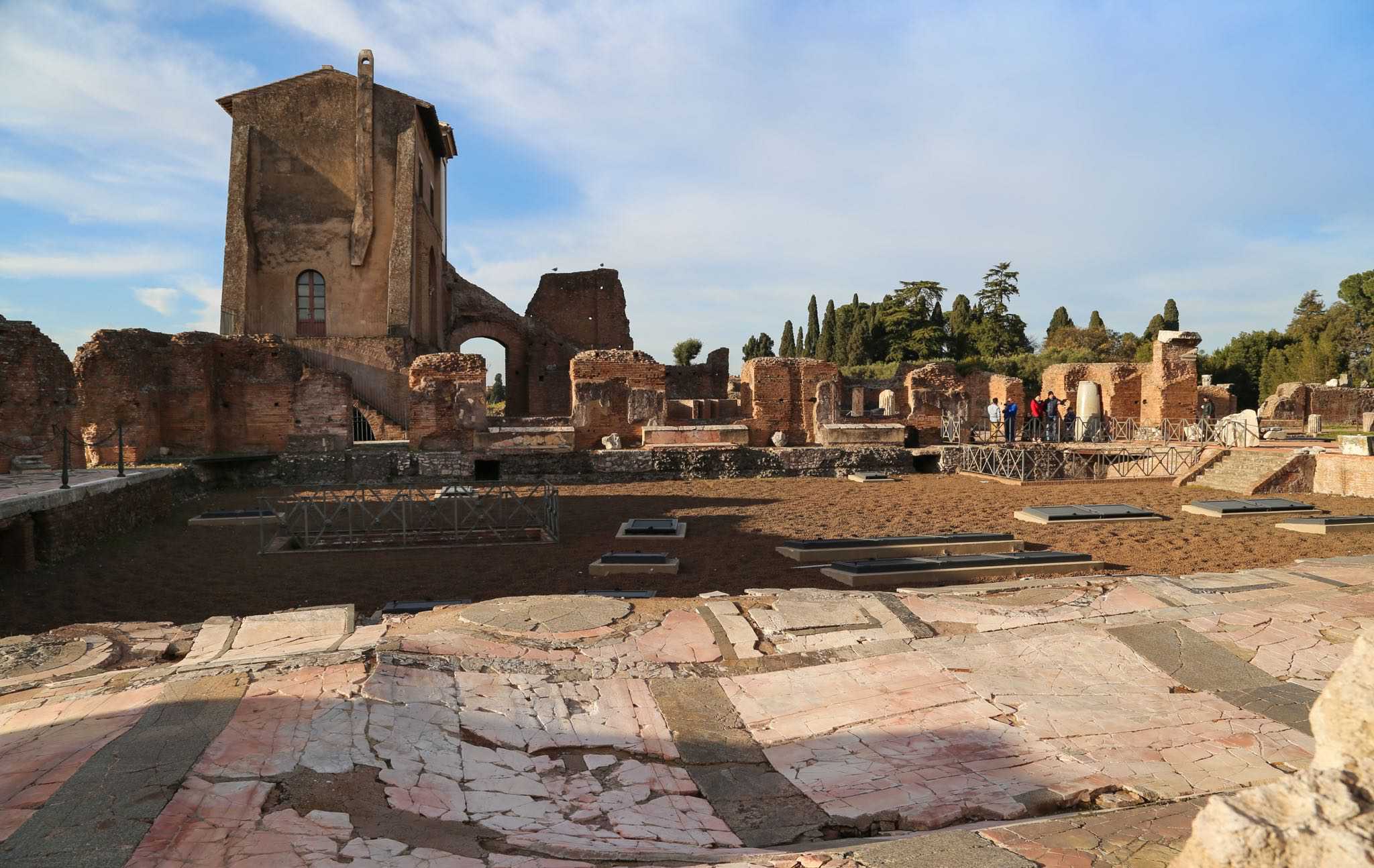
Over centuries an untold number of footsteps made their way along this palace concourse on the Palatine Hill, wearing the stone down.
Those who served as emperor are a storied lot within the Roman Empire. Some were good and capable men but many were simply awful. Julius Caesar, made famous by William Shakespeare’s play of the same name was a man of relentless ambition who lived by the sword and was stabbed to death by knife-wielding senators who had become fed up with imperious ways that began with the fateful crossing of the Rubicon River.

Make no mistake, for all the beauty to be found in Rome, it was a culture that was heavily engaged in war. The reputation of generals, and their ultimate success as emperor was due in large part to their success on the field of battle. This carving depicts just a slice of the many chapters of warfare Rome took part in.

Sculpture, since its beginnings, has always been an important form of art and the subjects took great pains, at great cost to portray themselves in the best light.

Commonly referred to as “The Galatian Suicide,” this magnificent piece is housed at the National Museum of Rome. It is a marble copy of a Greek bronze that has been lost of history. It belonged to Cardinal Ludovico Ludovisi, who acquired it in the 1600s. Sadly, the artist is unknown, but what is certain is the more talented the sculptor, the more expressive the result, as in this case, where great emotion is conveyed.

Once a piece of sculpture has been acquired, it become subject to wear and tear as it is transported, reacquired, discarded, and left for archeologists to rediscover. All-too-often small details of a piece are broken like the fingers on the right hand of the young man on the left.

Recreating the human form from a piece of marble calls for strength, stamina, but above all, talent. Here the artist does a magnificent job of showing the Greek goddess Aphrodite, who represented beauty, passion, and fertility. She has been a favorite subject of sculptors and painters for centuries.
One of the empire’s worst was Nero, who became emperor when he was just 16 years old. He began well enough, following the counsel of his mother, Agrippina, military advisors, and senators. But within a few years he became utterly craven, in love with himself, contemptuous of the ruling elites, the laws, and customs of Rome, and he thought he could control the masses because he was such a lovable fellow. Nero had transformed himself into an egocentric dandy and fool. He ended up killing his mother, spiraling further out of control. The murder of his mother was the beginning of a killing spree that played out during the latter part of his 14-year reign. Whether or not Nero set the great fire that destroyed a large portion of Rome in 64 AD, he wasted no time in taking advantage of the destruction. He appropriated large portions of land and set about building a massive imperial complex for himself called the Domus Aurea (Golden House).

Nero was considered by many to be one of the worst emperors in the history of the Roman Empire. He is rumored to responsible for the great fire that destroyed much of the city. Once much of Rome had burned, Nero wasted no time expropriating large sections of land to build his grand palace. In recent years the complex has been opened up for guided tours.

Nero spared none of the people’s money in adding lavish decorations and touches to the Domus Aurea. The site is still an excavation-in-progress so visitors are required to wear hardhats. The architectural element in the upper right corner is a barrel vaulted ceiling, made possible by simply repeating the arch design.

As just one example of the extravagance that Nero demanded for his grand palace, there are at least 100,000 pieces of mosaic tiles in this floor.

Walls, arches, and ceilings were elaborately decorated in the Domus Aurea.
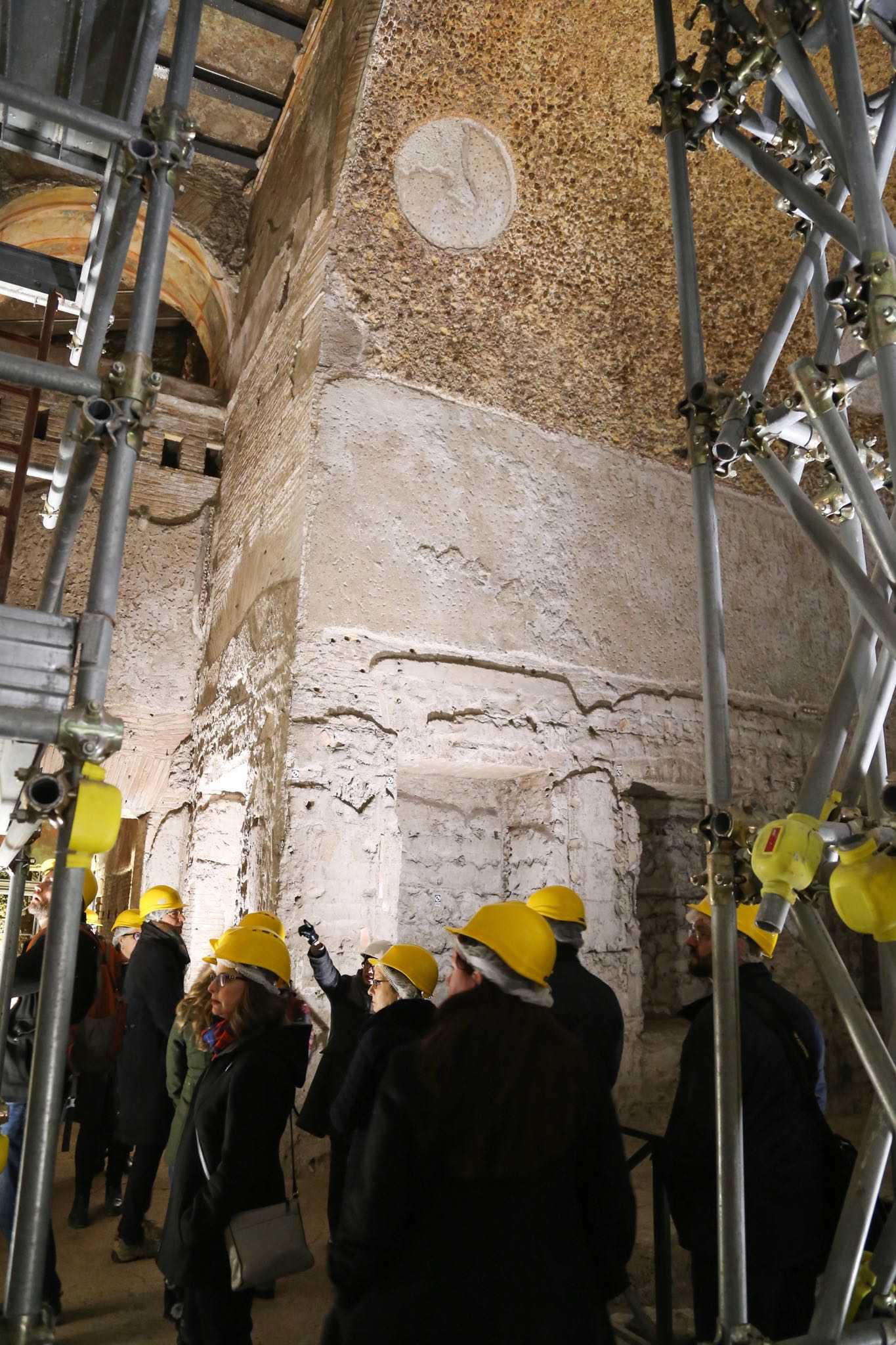
A guide points out and explains some of the significant features that have recently been uncovered in the Domus Aurea.

Today, the Domus Aurea gives off an eerie feeling, knowing that Nero walked these halls as he lived out a life of excess as a debauched murderer and an incompetent ruler.

This oculus was one of the center pieces at Domus Aurea, and like the oculus found at the Pantheon, it is open to the sky to allow light to enter, which also means rain will fall into the room. It is believed this room served as a banquet hall for Nero.
But Rome produced emperors who served the empire well (though the people of conquered lands would surely disagree). Augustus was emperor from 27 BC to 14 AD and during his time he brought Egypt, Dalmatia, parts of Africa, Germania, and southwest Spain under Rome’s sway. Augustus overhauled the tax system, established police and fire brigades, undertook a number of public works projects for Rome, and improved communications.

Having a bust sculpted was costly, but something that wealthy people have done for thousands of years. The Romans kept artists busy, and the museums of Rome are filled with those who were great, near great, and wealthy.
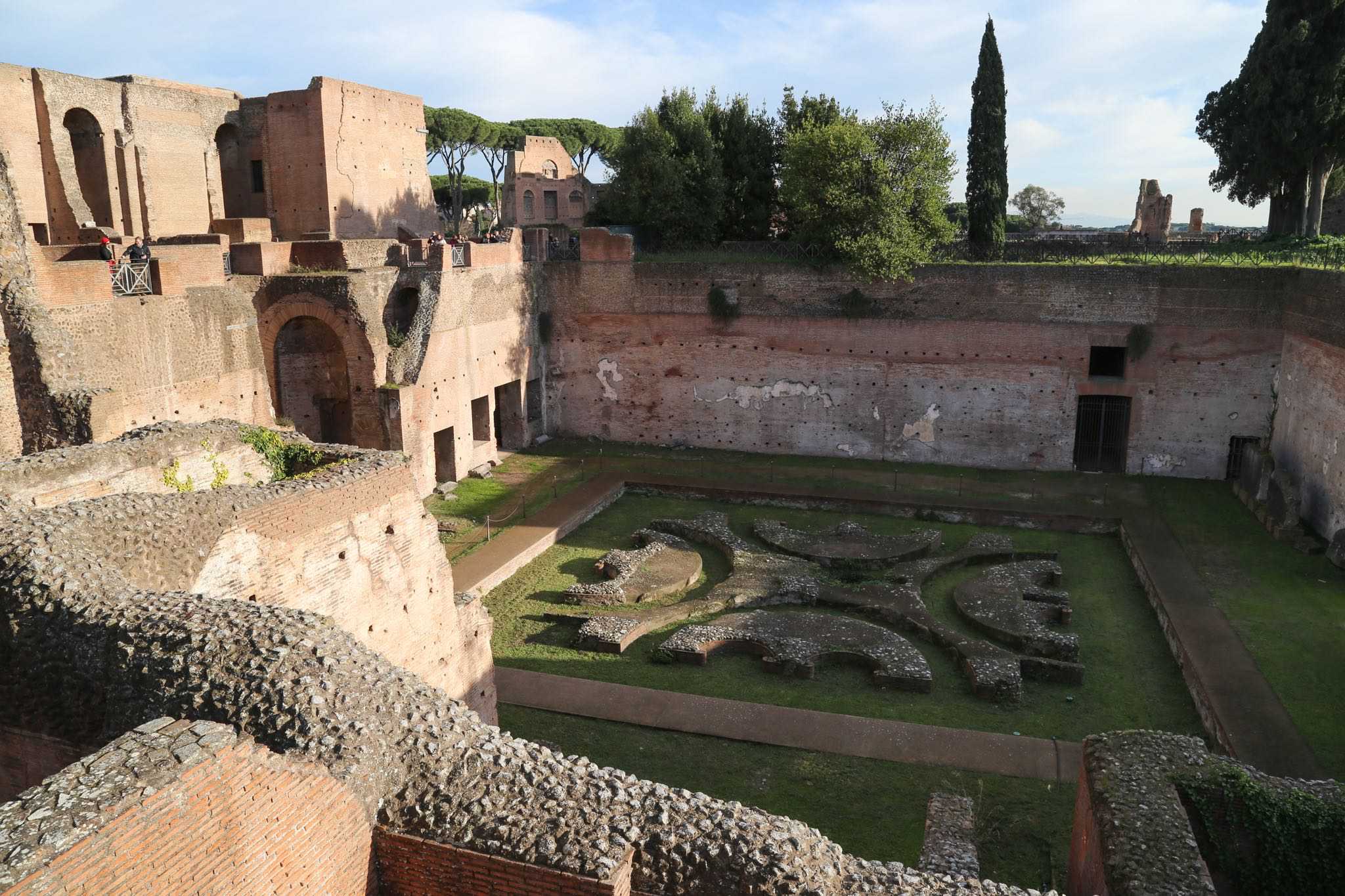
The restored garden of this Palatine palazzo — palace — shows a place of beauty where people could relax, discuss the events of the day, or hatch a new plot to seize power.

Trevi Fountain is one of the top draws for tourists visiting Rome. The story is, toss one coin in the fountain and you will return to Rome. Toss two and you will fall in love. And three coins tossed into the fountain means you will return to Rome, fall in love, and marry. The money collected is donated to worthy causes.
Trajan was emperor from 98 through 117 AD and he also expanded the empire, subsuming gold-producing regions of what is now part of Eastern Europe. He embarked on a series of public works projects in Rome, including the now-famous market that bears his name. The improvement of roads, canals, bridges, and communications enhanced military effectiveness.
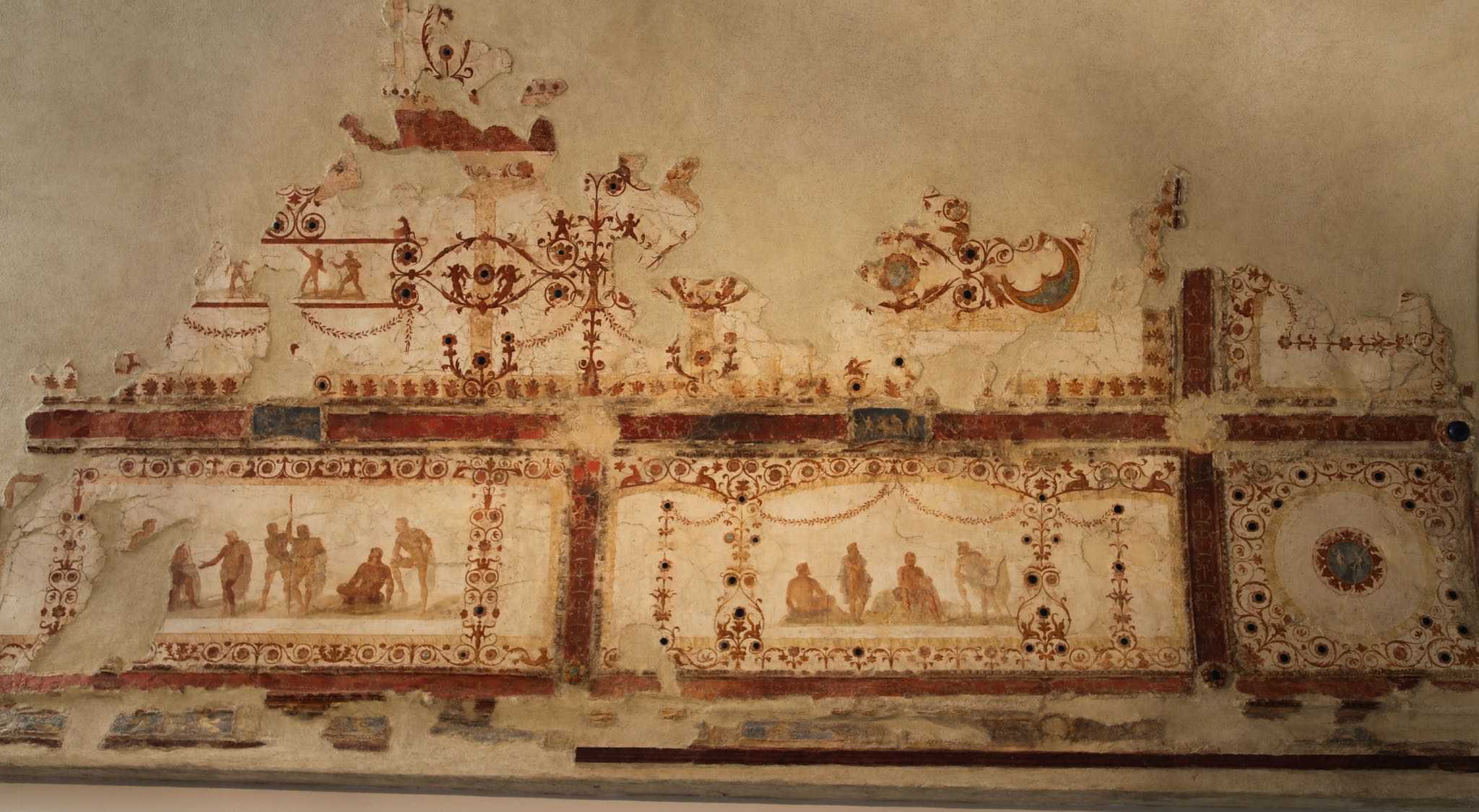
In ancient Rome sculpture was more advanced than painting, which which would need a few more centuries to develop dimensional characteristics, expressiveness, and a greater palette of color. It is one reason that mosaic tiling and painting on walls was a fashionable expression of art.

Inside Porta San Paolo are a number of artifacts available for close-up viewing. It was not uncommon for the marble bust of someone to have the nose broken, intended as an insult to that person, as the piece on the right shows.
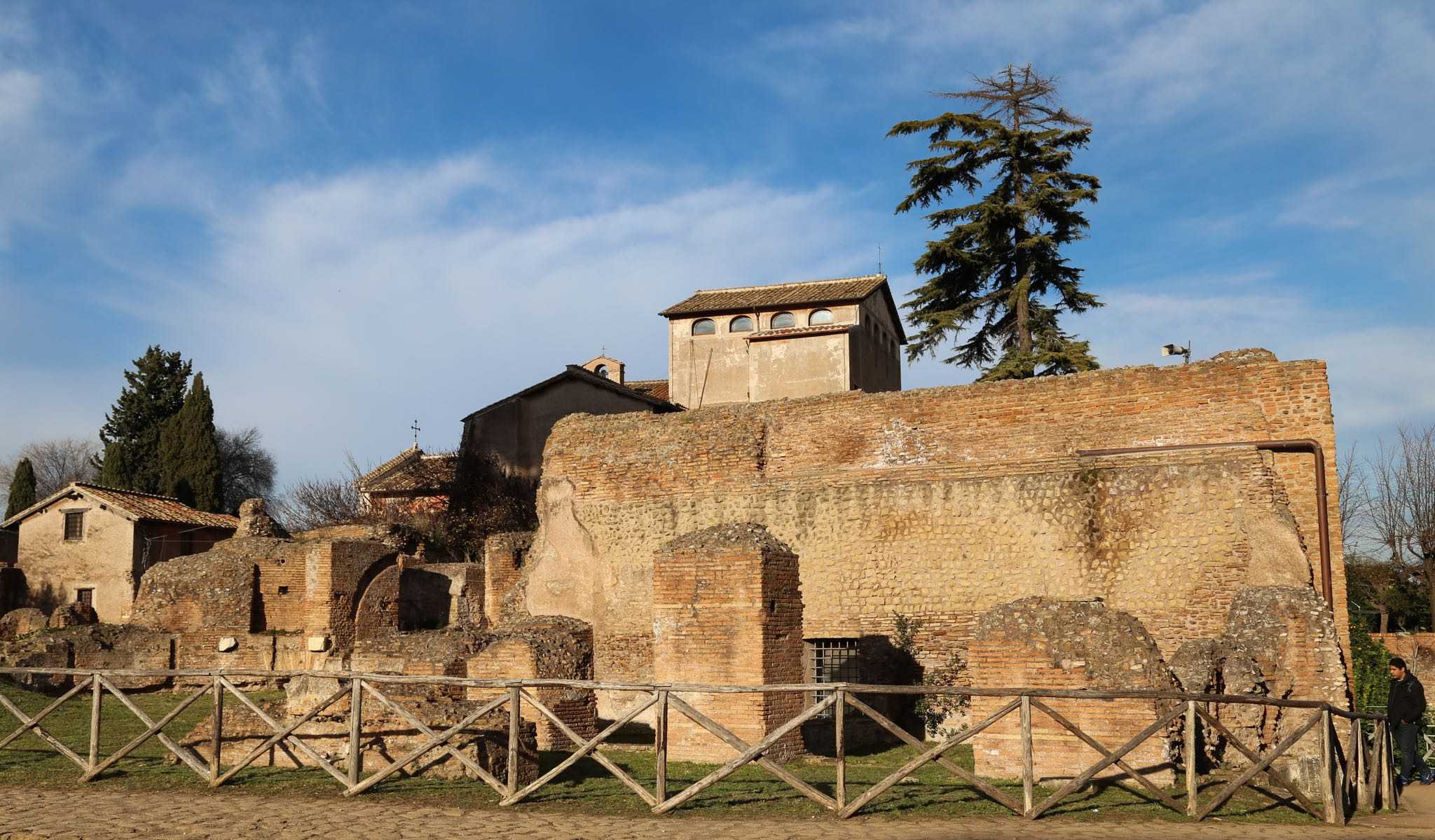
To be a citizen of during the time of ancient Rome brought with it many privileges. It meant the right to acquire property, and engage in politics which is a direct route to power. Originally, both parents had to be citizens of Rome, though later generals and emperors could convey citizenship.
Hadrian served as Roman emperor from 117 to 138 AD and his reign is generally marked by an era of peace (but in battle he could be a brutal, as when he slaughtered 580,000 Judean Jews). He traveled extensively throughout the empire. Recognizing the limits of the Roman Empire in what is today England, he ordered the construction of a 73-mile wall that bears his name, and is a UNESCO World Heritage Site.

This sculpture of the river god Arno was commissioned by Emperor Hadrian, and was inspired by a Greek sculpture.

The Sarcophagus of St. Helena sits in the Vatican Museum and the carvings depicts Roman cavalry riding above conquered barbarians. Helena was the mother of Constantine the Great, and she died and was buried in it in 329 AD. The material, known as prophyry, was highly prized.
And Marcus Aurelius served from 161 through 180 AD and is considered the Philosopher Emperor. He defended free speech, even when it was critical of him. He was considered a fair and just emperor, and a stable and capable administrator. When the Tiber River flooded in 162 AD he was praised for his crisis management. And Marcus Aurelius was also a talented writer; so much so that his 12-volume, “Meditations” made it to the best-seller list in 2002.

The Round Hall, part of the Vatican Museum was built in the 1770s and includes niches for larger-than-life statues, and a gigantic red porphyry bowl that measures 13 feet in circumference, sitting on mosaic tile work that recreates scenes from the 3rd Century AD.

During the summer months this area near the Forum and Senate would be filled with tourists, but in the off season and winter months the crowds are lighter, access is easier, and the chance to take photographs with ease is a much more pleasant experience.
Today Rome is one of the most popular tourist destinations in the world and peak travel months result in a crush of visitors. With attractions like the Colosseum, Pantheon, the Senate and Forum, Vatican, a number of first-rate museums, excellent food and wines, and ancient ruins everywhere you turn, there are any number of activities for visitors to take in. Istat, the Italian Institute of Statistics, suggests approximately 290 million people visited Rome in 2018. Travel in the off months and shoulder seasons makes for a much less crowded experience.

One of the excellent attractions for any visit to Rome is the Pantheon. It has been beautifully preserved and is an outstanding engineering and architectural achievement. The walls and ceiling are made of concrete. It was commissioned during the reign of Augustus (27 BC — 14 AD), was completed while Hadrian was emperor, and dedicated around 126 AD. It began as a Roman temple to “all the gods,” hence the name Pantheon. It is now a church known as the Santa Maria Rotunda.

The story of the Crucifixion of Jesus Christ is a central element in catholic faith and paintings and statuary retelling the event can be found in nearly every church in Rome.
In addition to the fascinating history of the Roman Empire, the city offers visitors a great deal to see and enjoy. For example, Florence may be considered the birthplace of the Renaissance, but at one time or another virtually every painter, sculptor, or scribe of any significance during the Renaissance made their way to Rome. Michelangelo’s home was Tuscany, but some of his greatest works are found in Rome. His frescoes of the Sistine Chapels, the sculpture Pietà, and other works can be found throughout the city. Bernini is one of the great sculptors of all time (he was also a highly respected architect and painter), and he spent much of his life in Rome. Many of Bernini’s works (both standalone sculptures as well as fountains), can be found throughout the city. Bernini had the rare gift of transforming cold marble into something that appears fluid and alive. Other Grand Masters such as DaVinci (he spent three years in Rome), Caravaggio, Raphael, Titian, Botticelli, and other great artists worked in Rome during at some point in their careers.

This is the Aventine Keyhole on property originally held by the Priory of the Knights of Malta that looks to St. Peter’s Basilica. It was originally owned and controlled by the Knights Templar.

The Vatican Museum is one of the greatest in the world, in terms of the number of artifacts and pieces in its possession. The curved ceiling along this hallway in the Map Room is just one example of the exhibits visitors can see.

In the middle of one of the interior courtyards within Vatican City is the contemporary sculpture by Arnoldo Polmodoro titled, “Sphere Within a Sphere.”

The Vatican Museum is hugely popular both for its sheer size, as well as the magnificence of the collections. This gallery filled with a dizzying array of ancient sculptures is just one of 1,400 exhibit rooms in the Vatican visitors can see.

Bernini’s Fountain of the Turtles (Fontana delle Tartarughe), is in Piazza Mattei and is one of his outstanding public sculptural works.

“Rape of Proserpina” is housed at the Galleria Borghese in Rome, and is one of the best examples of Bernini’s monumental talent sculpting marble. Begun in 1621, Bernini was just 23 years old when he finished the piece in 1622. The story depicts the abduction of Proserpina by the god Pluto who wants to to take her to the underground. Cerberus, the three-headed hound that guarded the gates of Hell are in the foreground. Notice how Pluto’s right hand grips her thigh, his fingers pressed into her flesh, an eternal testament to Bernini’s unmatched skill.

“Damned Soul” is another marvelous example of Bernini’s skill. Completed in 1619 it is normally housed in the Palazzo Monaldeschi in Rome.
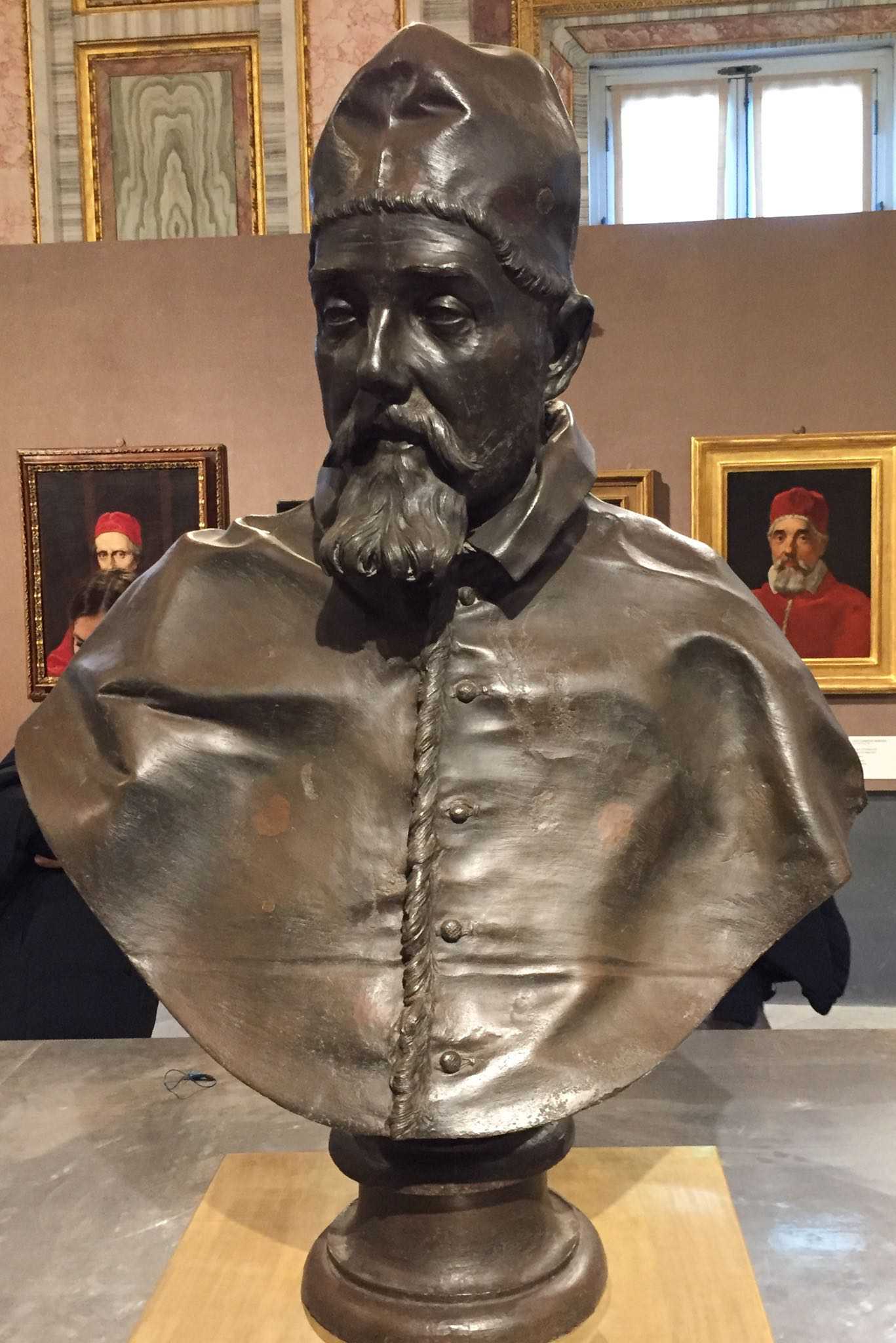
Pope Urban VII was one of the great art patrons of the Roman Catholic Church an avid collector of Bernini’s works. It was completed in 1633, and this exhibit at the Galleria Borghese includes paintings of Urban, also painted by Bernini.
Rome holds another distinction – it is the only city in the world that encircles another country, in this case Vatican City, the seat of the Roman Catholic Church. The smallest country in the world, at 110 acres, Vatican City gained sovereignty thanks to a 1929 treaty Pope Pius XI signed with Benito Mussolini. Vatican City has a total population of about 1,000, is the home of the pope, the Swiss Guard sworn to protect him, and the wealth that is a major part of the Roman Catholic empire. More than five million people flock to the Vatican each year to take in sights like the vast museum and the Sistine Chapel (with as many as 22,000 visitors daily during peak summer months). Tickets cost between $21 – $65 (depending on the type of admission), generating anywhere from $105 million to $250 million each year.
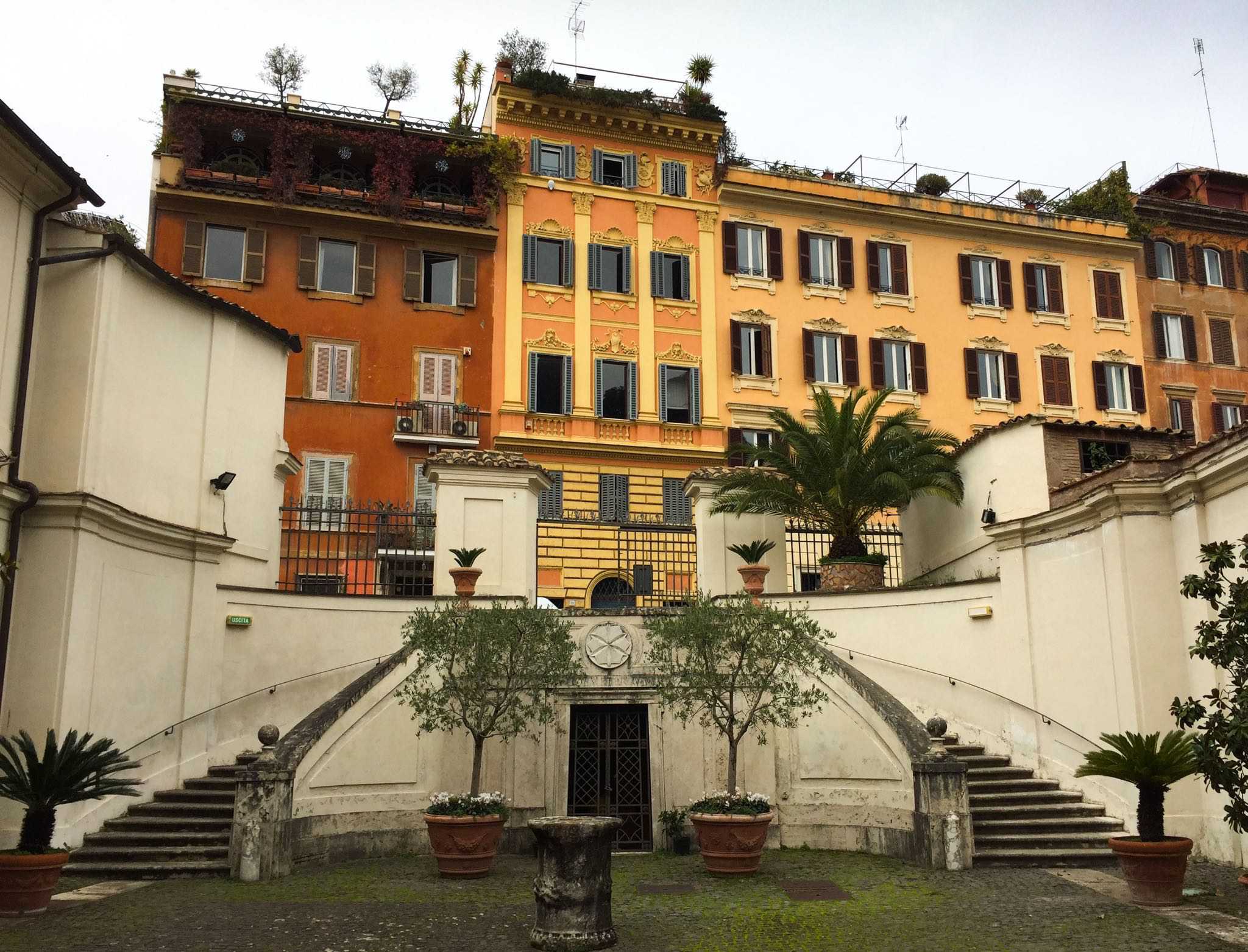
Rome has a beauty all its own and it is the type of place where you can wander as you walk, and you are sure to find beautiful sights nearly every step of the way.

Percy Bysshe Shelley was one of the great poets of the Romantic era, and he is considered one of England’s greatest poets. Tragically, Shelley did not see fame and riches during his lifetime, and he died at the young age of 29, in 1822. Upon his death writers and readers began to recognize the power of his works. His ashes are interred here at the Protestant Cemetery in Rome.
Rome is known as, “The Eternal City,” but how did that moniker come about? Thanks to some clever wordsmithing, the Roman poet Tibullus coined the phrase sometime in the 1st Century AD. The notion then – and now – is that Rome is such a grand place, so important, so special, an idea and a place that will last forever. And for anyone who has ever walked her cobblestone streets, taken in the magnificent sights, and experienced the history of this unique city will always consider Rome “The Eternal City.”
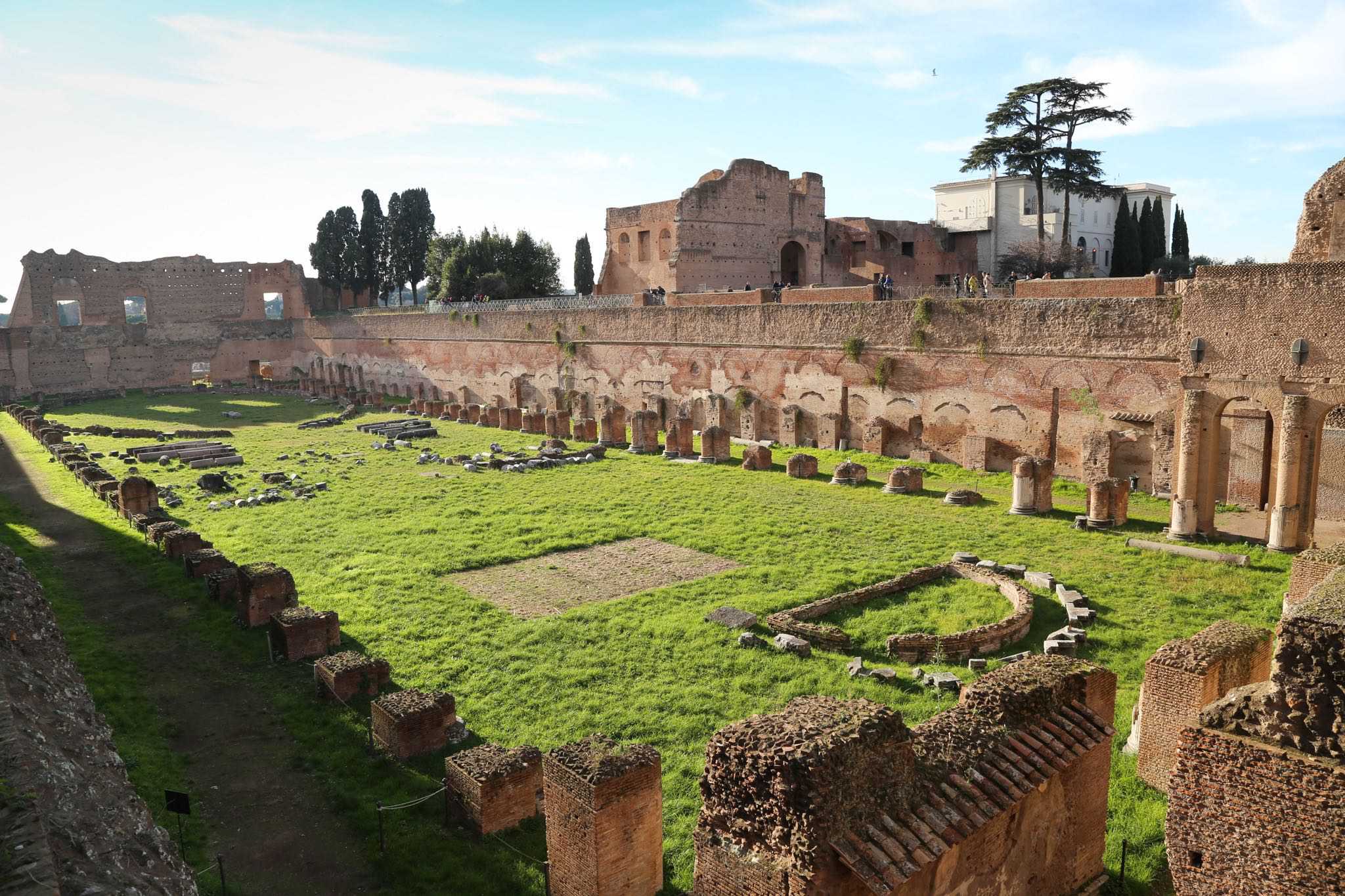
Rome has and will always be one of the world’s special cities. It has made lasting contributions to the worlds of architecture, building, military achievements, writing, cuisine, and other areas.

The treasures of ancient Rome are still being discovered. As the City of Rome expands its metro system to add a new stop, the station that will stop at the Forum (concealed by the orange wall), unearthed a trove of artifacts, prompting another archeological dig to preserve the pieces and better understand the history.
For more information about Rome and its history, click over to these websites:
britannica.com/Rome/The-Colosseum-and-the-Arch-of-Constantine
